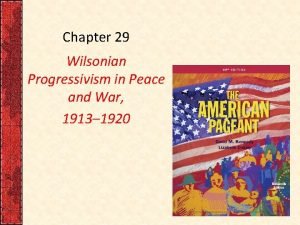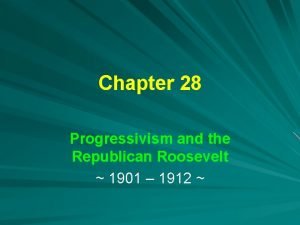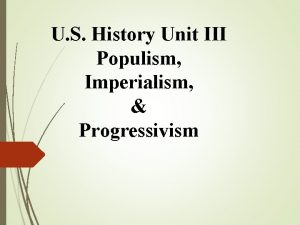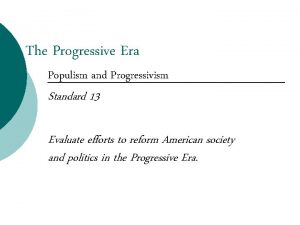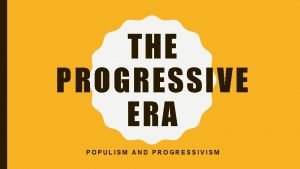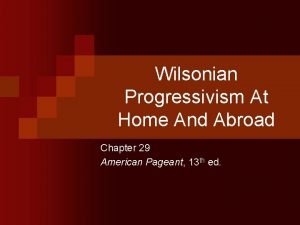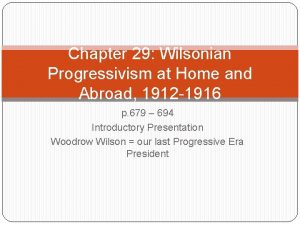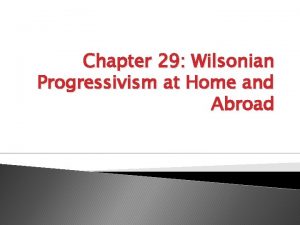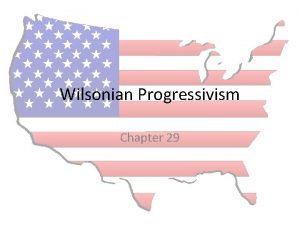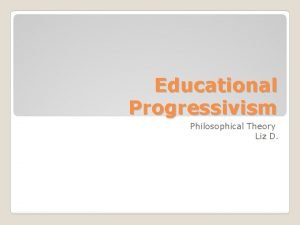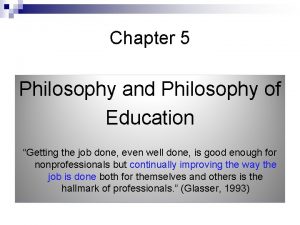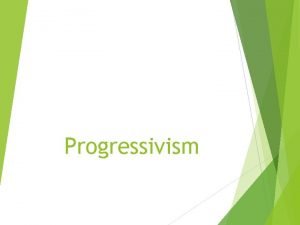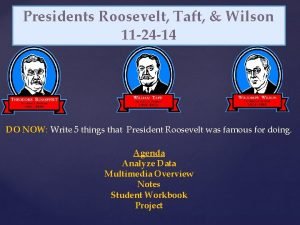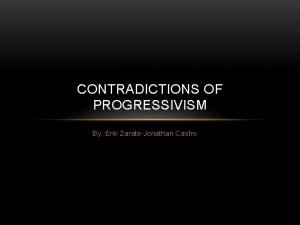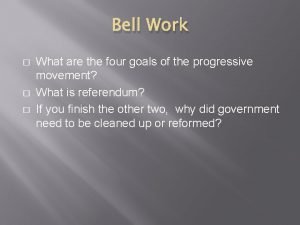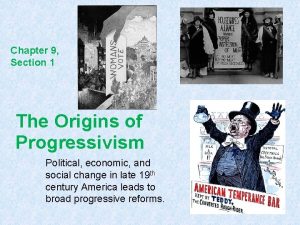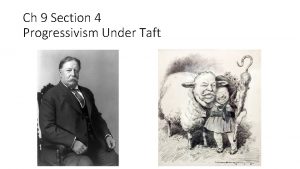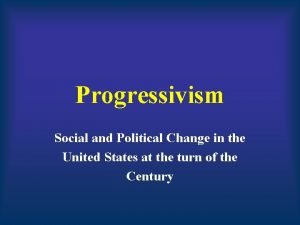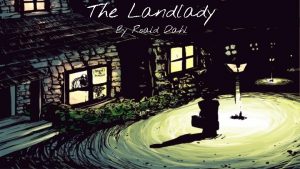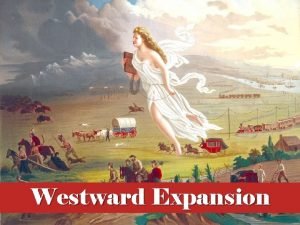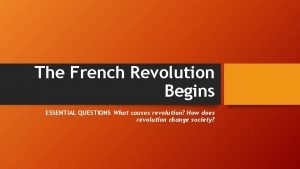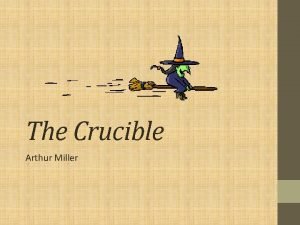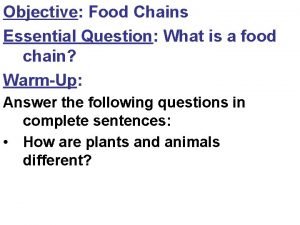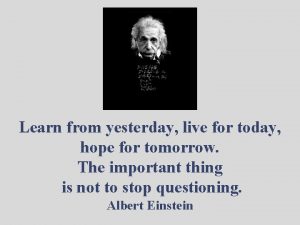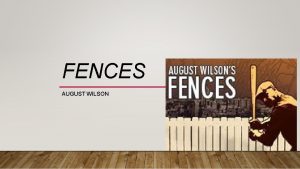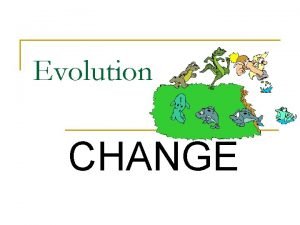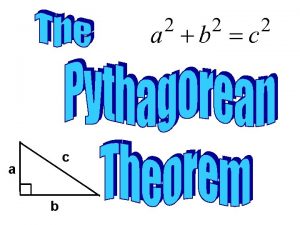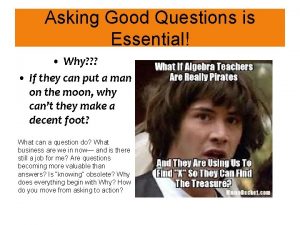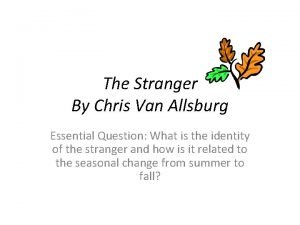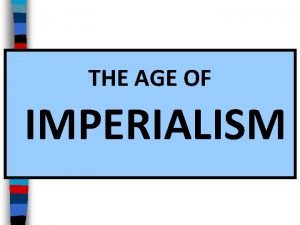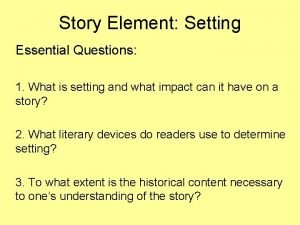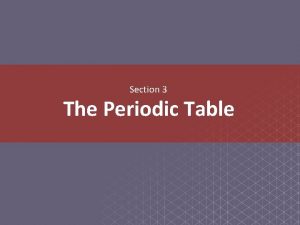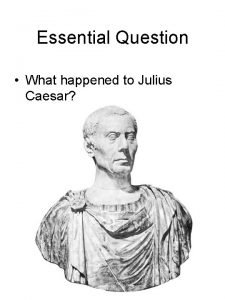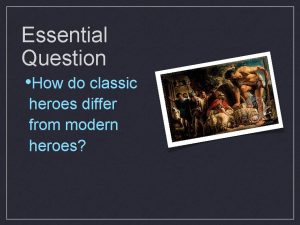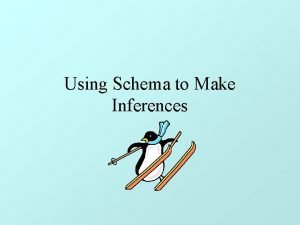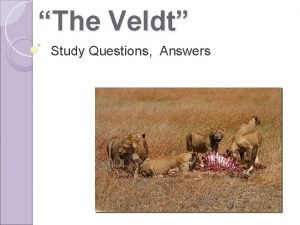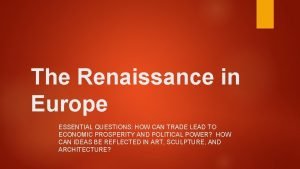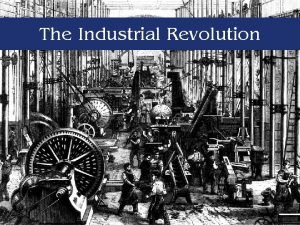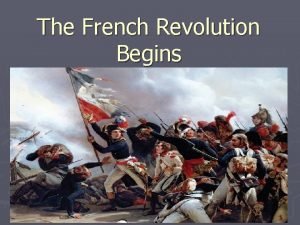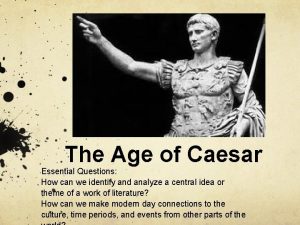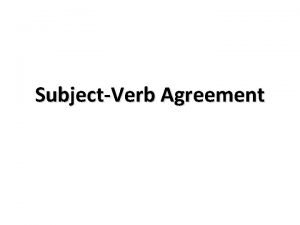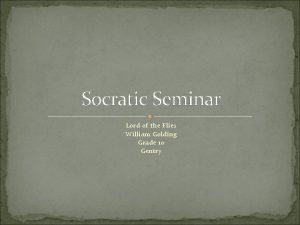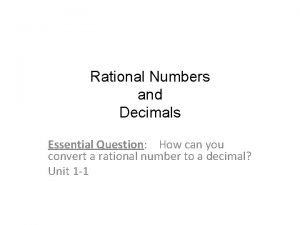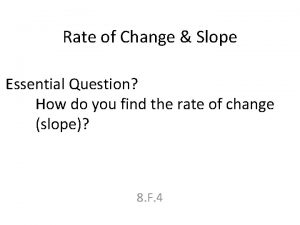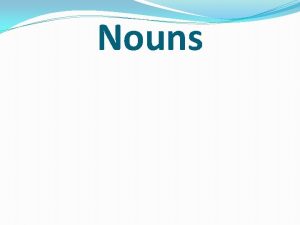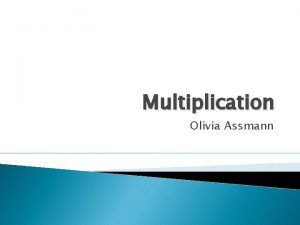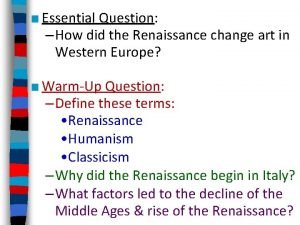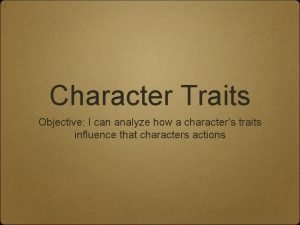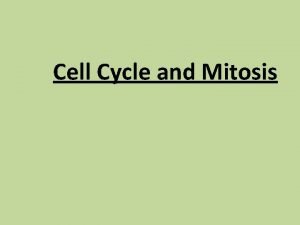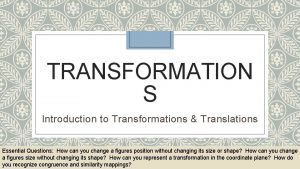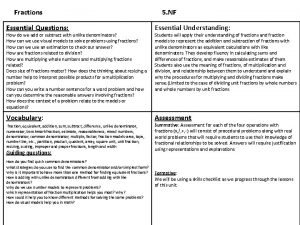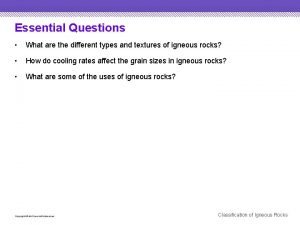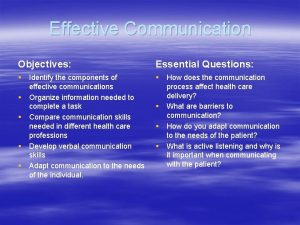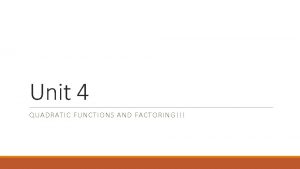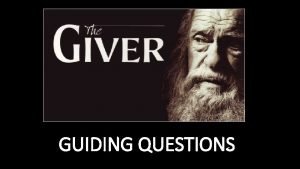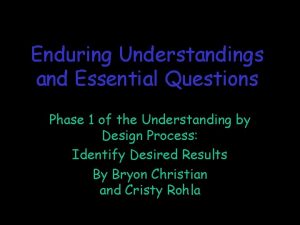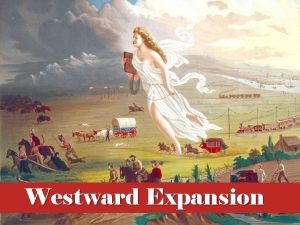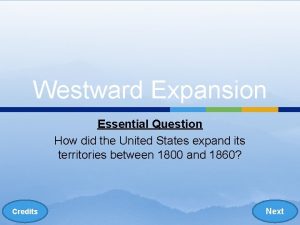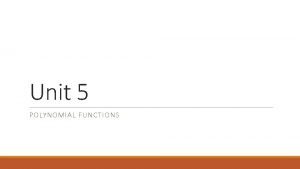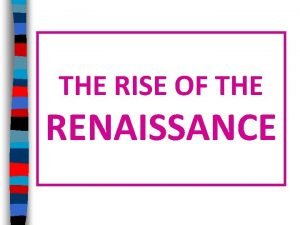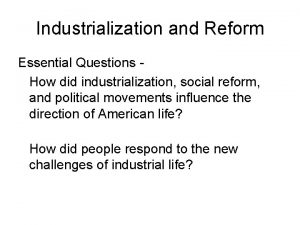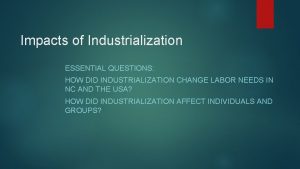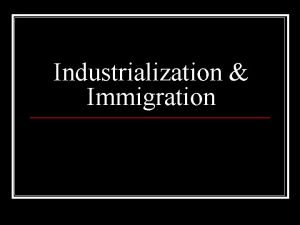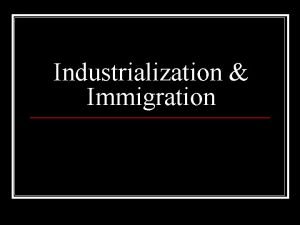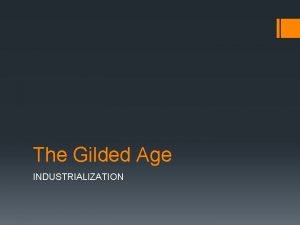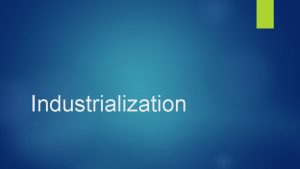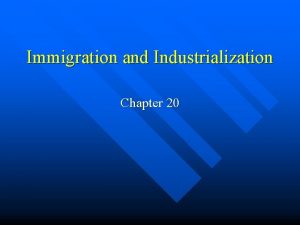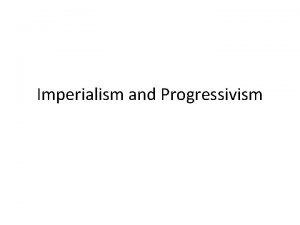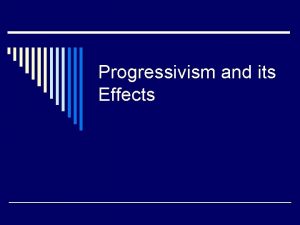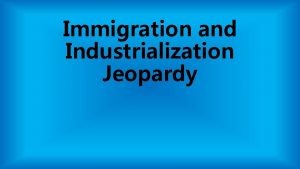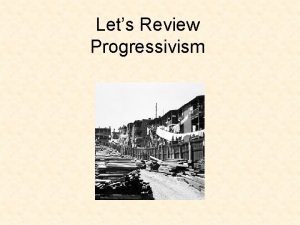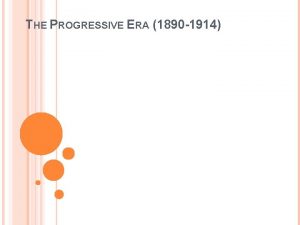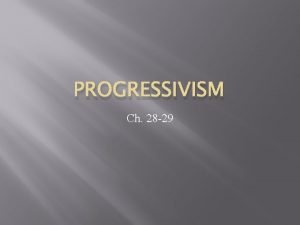Essential Questions Immigration Industrialization and Progressivism Immigration Industrialization





































































































- Slides: 101

Essential Questions: Immigration, Industrialization, and Progressivism Immigration Industrialization Progressivism 1. Why do Immigrants come to 1. How did Progressivism The United Stares and what Industrialization and change politics and impact did they have upon new technology affect society in the 19 th society? the economy and society? 2. What was life like for 2. How did big business century? Immigrants in the US during shape the American the 19 th century? economy in the late 1800 s and early 1900 s?

Immigration 1840 - 1914 Essential Questions: • Why do Immigrants come to The United Stares and what impact did they have upon society? • What was life like for Immigrants in the US during the 19 th century?

Immigration Quick Questions: What percent of United States citizens are immigrants or descended from immigrants? - 99. 9% What is the longest unfortified border in the world? - Canada and the United States What ethnic group do Americans claim more than any other as their primary ancestry on the US Census? - German… with Irish a close second

Immigration to the United States • Three Phases of Immigration to the United States – First Wave – Colonial Period 1600 s – 1700 s • English/ Scots Irish Immigrants – Family immigration first in New England (largest population growth during colonial period) – Second Wave – 1840 s – 1920 s • 1840 s – 1870 s = Irish & German Immigrants (Northern European) – Irish = Potato Famine and ‘the Troubles’ continue to create push factors • 1870 s – 1920 s = Italian & Polish immigrants (Southern and Eastern European) – Often chain migration (one family member makes enough $ to send of other family members) or Temporary Migration (return to home country after a few years) – depends on push factors – Third Wave – 1965 (Immigration Leg. ) – Present • Current Immigration primarily from Asian, Latin America (Mexico) • Often Circle Migration

‘Old’ Vs. ‘New’ Immigrants ‘Old’ Immigrants (First Wavers) ‘New Immigrants” (2 nd Wave) Protestant, White, English or Scots-Irish Decent, All spoke English • Catholic/ Jewish (Not Protestant) • Didn’t always speak English • Very Poor • Often created Ethnic Enclaves (Little Italy, etc. ) • • Outcome: 1. Clash of Culture 2. Prejudice 3. Anti-Immigrant Policies

New vs. Old Immigrant Groups


Anti-Catholic Political Cartoon



I. New Immigrants come to America When? Who? A. Two ‘Phases’ of Immigration 1. Irish/ German 2. Southern/Western Europeans (often Polish & Italian) B. Often unskilled, poor, Catholic or Jewish (big generalization… but remember the push factors) C. Majority Settled in Cities & contributed further to Urbanization

II. Why do Immigrants decide to leave home? Push and Pull Factors Push Factors

II. Why do Immigrants decide to leave home? Push and Pull Factors Job opportunities Inexpensive land Family reunification better living conditions Political and/or religious freedom – Education – – – Push Factors – Lack of job opportunities – Low standard of living • Famine, poverty, and war – Lack of religious freedom – Lack of educational opportunities – Poor medical care – Natural disasters


Immigrant Explorer Activity Historical Migration Task: Analyze the Interactive Immigration Map to determine Who is coming to the US and Where they are settling.

Immigration to the United States • Three Phases of Immigration to the United States – First Wave – Colonial Period 1600 s – 1700 s • English/ Scots Irish Immigrants – Family immigration first in New England (largest population growth during colonial period) – Second Wave – 1840 s – 1920 s • 1840 s – 1870 s = Irish & German Immigrants (Northern European) – Irish = Potato Famine and ‘the Troubles’ continue to create push factors • 1870 s – 1920 s = Italian & Polish immigrants (Southern and Eastern European) – Often chain migration (one family member makes enough $ to send of other family members) or Temporary Migration (return to home country after a few years) – depends on push factors – Third Wave – 1965 (Immigration Leg. ) – Present • Current Immigration primarily from Asian, Latin America (Mexico) • Often Circle Migration

Arriving in America • Interpreting Ellis Island Arrival Information Process 1. Steamship to Ferry • Describe the process immigrants went 2. Medical Inspection through on Ellis Island. 3. Legal Inspection Proceed to New York 1. 2. 3. http: //www. history. com/topics/ellis -island/videos/arrival-at-ellis-island http: //www. history. com/topics/ellis-island/videos/theellis-island-medicalinspection? m=528 e 394 da 93 ae&s=undefined&f=1&free =false http: //www. history. com/topics/ellis-island/videos/hurdles-tocitizenship-on-ellisisland? m=528 e 394 da 93 ae&s=undefined&f=1&free=false

Immigration Centers Prior to 1890 Immigration Centers 1892– 1954 Canada – Goose Island Ellis Island - NYC Deer Island - Boston Immigration Centers 1965 – Present LAX Airport – Los Angeles Castle Garden - New York Southwest Immigration Detention Centers

Citizenship in The United States • Naturalization Act of 1790 – 1 st Law regulating the granting of national citizenship – Limited naturalization to ‘free white persons, ’ required 2 yrs of residence, your father had to be a citizen • 14 th Amendment (1868) – Granted citizenship to people born in the US regardless of race, or place of birth. (not extended to American born children of Chinese parents till 1898 – court case)

Immigration Regulation • Chinese Exclusion Act (1882 - 1943) – Stopped the immigration from Asia • Immigration Act of 1924 – Put quotas on how many immigrants were permitted based on country of origin (skewed towards Northern Europeans) • Immigration and Nationality Act of 1952 – Abolished racial restrictions but retained a quota system for nationalities and regions (preference system based on ethnic group and labor qualifications) • Immigration and Nationality Act of 1965 – Abolished the national-origin quotas system • Immigration Act of 1990 (signed by George Bush) – Increased legal immigration to the US by 40% – Increased enforcement of Immigration laws post 9/11

U. S. Immigration Policies · 1980, Refugee Act - quotas do not apply to those seeking political asylum · 1986, Immigration Reform and Control Act admitted large numbers of former illegals. · 1990, Immigration Act raised global quotas to roughly 675, 000 · 1995, visas issued Preferentially: – 480, 000 - to relatives of people here – 140, 000 - to those with special skills and education – 55, 000 - to diversity candidates (i. e. , mostly not from Latin Amer. or Asia) Current Total: 675, 000 http: //www. kcra. com/news/could-you-passthe-us-citizenship-test/24414658


• The US allows more than 1 million immigrants to become Legal Permanent Residents every year *Based on number of Permanent resident visas issued.

The Immigrant Experience Jigsaw Instructions • Warm up Task: Summarize the instructions for the jigsaw in your own words and have your main group representative bring me your summaries and any questions your group might have. • Each of you have been put into “main groups” for phase 1 of this activity with one individual assigned the task of group representative. You will also have a “Color group” for Phase 2 of this activity based on the color on your document sheets. • Your main group will be given a document to analyze. You will become the Expert on this document by answering the document questions and present this information to your color group. • Your color group will create an organizer that includes information on a number of diverse aspects of the immigrant experience during the 19 th century based on the 4 different document sources from each main group. • Once your color group has completed the organizer for the documents your color group representative will get 4 photos on living and working conditions for you to analyze as a group. • Your color group should then have a brief discussion on what supporting details you have found that could help you answer the question: Was 19 th century American a land of opportunity for immigrants? • Exit Slip: At the end of the lesson you will reflect on what you learned during the lesson and your impression of the lesson itself. • *the information that you collect today will be used to complete an argumentative essay. Your groups should focus on finding supporting detail that would be useful in an argumentative essay.

Was 19 th-century America a land of opportunity for immigrants?

Positive Experiences Negative Experiences Doc 1 – Letter’s Home Positive – Evidence of Economic Success 1. Doc 3 – Two views on the Nativist Perspective Negative - Evidence of Economic Failure 1. 1. Positive – Evidence of Positive Experiences in American Society 1. Negative – Evidence of Negative Experiences In American Society 1. 1. Doc 2 – Oral History of Frank Klosowski Positive – Evidence of Economic Success 1. Doc 4 – Two view on the impact of Immigration Negative - Evidence of Economic Failure 1. 1. Positive –Evidence of Positive Experiences in American Society 1. Negative – Evidence of Negative Experiences In American Society 1. 1.

Photographic Analysis of Living and Working Conditions Living Conditions Photo 1 – Italian Immigrant Family 1897 Working Conditions Photo 2 – Coal Miners in 1920 What observation can you make about working conditions in this What observations can you make about the living conditions in this photo? Photo 3 - Slumdwellers salute Photo 4/ 5 – Pictures of Immigrant Businesses What observations can you make about educational opportunities and the purpose of education in the United States at this time? What economic opportunities did America offer to immigrants that their home countries did not?

How do Immigrants Change America? • Fuel Industrial Growth – Labor supply for factories • Encourage rapid urbanization (especially in Northeast & Midwest) • Made their traditions a part of American Culture – Multiple Theories on the impact of immigration on US Culture – Process known as Cultural Assimilation • How do Immigrants become American?

Case Study: The Immigrant Experience • The US is a land of immigrants, but what does that mean? – Melting pot – Salad bowl – Or something else?

Different Theories on the Impact of Immigrants on US Culture Melting Pot Model/ Classic Assimilation • a metaphor for a heterogeneous society becoming more homogeneous (into a harmonious whole with a common culture) Salad Bowl/ Cultural Pluralism • 1970 multiculturalism model • Metaphor for different cultures mixing, but remain distinct.

‘Child’s Plate/ Multiple Consciousness Model • Proposes that immigrants need not completely abandon their culture and traditions in order to reach the goal that the melting pot theory seeks – a common culture/ with immigrants considering themselves citizens of their new nations first

Paragraph Structure • Topic Sentence (argument & reference your position) • Structure Example for using Supporting details in a sentence: – Tag quote, “piece of evidence that supports your statement. This can be a direct or indirect quote or a description of a visual source, but it must relate to the statement that you have made, ” (Abbreviated Citation). Explanation on the significance of the evidence and how it related back to your argument. • Conclusion

Theories on Immigrant Assimilation How Do Immigrants Become American? The ‘Melting Pot’ Model The ‘Salad Bowl’ Model Summarize: Strengths Weaknesses Strengths The ‘Multiple Consiousness’ Model Summarize: Weaknesses Strengths Weaknesses

Industrialization The time period in which America changes socially and economy from an agrarian society into an industrial one. Industrial Model = production of a good broken down into separate tasks in a factory which, with the use of technology, creates Mass Production. Review from WH 2 What were the benefits and drawbacks of Industrialization in England? Benefits Drawbacks

• Fast Fact America the Story of US The Creation of Cities – The largest internal migration in US history was the rural to urban migration that occurred in the late 1870 s – 1920 s What elements were necessary for the creation of the Modern US city? 1. 2. • Immigration + Industrialization created a unique urban landscape 3. 4.

Industrialization Causes • The Civil War • Vast amount of natural resources • Entrepreneurs • Large number of immigrants • Protective Tariffs • Laissez-Faire Economics • New inventions • Expanding railroad systems Effects • Factories, railroads, and mines created new jobs and drew foreign investors • American made goods became cheaper than imported goods (dominate the world market) • Businesses operated with little gov’t regulation (low wages, dangerous conditions, Environmental damage, etc…) • Mass production of goods

The Rise of Large Corporations Rise of Corporations • Monopolies • Cartels • Horizontal Integration • Trusts • Vertical Integration Debates over Big Business • Small Businesses bought up or squeezed out by competition • Consumers paid high prices • Providing Jobs • Business leaders as philanthropists • • Andrew Carnegie: U. S. Steel (1870 s) John D. Rockefeller: Standard Oil (1880 s)

A company controls an entire industry or area of the economy Review from WH 2 Because of its size and power, the company can destroy any competition Lack of competition means company can charge what they want for the product

Monopolies Standard Oil, 1906

Standard Oil • http: //www. pbs. org/wgbh/amex/rockefellers/sfeature/sf_1. html

How is big business portrayed today? How are these cartoons similar or different from the late 1800 s cartoon?

Brainstorm Laissez-faire vs. Regulation • Should government become involved in business? Pros of Governmental involvement Cons of Government Involvement News: Septempber: 2011 - The U. S. Department of Justice filed an antitrust lawsuit against AT&T on Wednesday seeking to block its $39 billion merger with T-Mobile. The merger would create the largest wireless company in the United States, combining AT&T's 98 million customers with TMobile's 34 million users, for a total of 130 million subscribers. AT&T is currently the second-largest wireless company by number of subscribers, and T-Mobile is fourth. The DOJ said the merger would lead to a situation in which just two companies -- the AT&T-T-Mobile combination and Verizon Wireless -- would dominate the mobile market. The new AT&T and Verizon would account for more than two-thirds of wireless subscribers and 78% of the wireless industry's revenues.

Working During the Industrial Age 1. How did Industrialization and new technology affect the economy and society? Activities – Analyzing Visual Sources 1. Read Summary of Labor Conditions and Create a list of ways to improve Labor Conditions 2. Observe Labor Conditions through Photo Analysis 3. Demands of the Labor Movement

Why should we learn how to Analyze Photographs as Primary Sources?

Practice Photo Analysis • Step 1: Observation • Step 2: In Depth Analysis • Step 3: Put Yourself in the Picture

Practice Photo Analysis • Step 1: Observation • Step 2: In Depth Analysis • Step 3: Put Yourself in the Picture

How does an In-depth Analysis Help you see additional detail in visual sources? What are working conditions like in a Factory?

Labor Condition and Demands Observed Labor Conditions How Improve Labor Conditions 1. Labor Conditions: 1. Suggestions:

Gradual Government Regulation 1. Railroad industry controls economy 2. Midwestern states pass laws regulating freight rates 3. Supreme Court strikes down state laws 4. Senate creates the interstate Commerce Commission 5. Senate passes the Sherman Antitrust Act

Characterization of American Industrialization • Urbanization (Growth of Cities) – City offers work, education & entertainment opportunities – Slum Conditions = crowding, crime & sickness • Growth of Big Business – New Business tactics – Profits for the rich – low wages for the laborers • Large Scale Immigration – Opportunities in America – Poor living & working conditions

Robber Barons or Captains of Industry Did Business leaders help or hinder the US economy during the American Industrial Revolution? • • Task: 1. Pick a Position – 2. Create 3 strong arguments supporting or opposing the question above. 3. Think of 2 pieces of supporting evidence (1 each for 2 of the Andrew Carnegie: U. S. Steel (1870 s) arguments) John D. Rockefeller: Standard Oil (1880 s)

Responses to Industrialization and Unrestrained Capitalism The Labor Movement Grows Workers Suffer - Long Hours - Sweatshops - Dangerous Conditions Strikes Break Out - Haymarket Riot - Homestead Strike Pullman Strike Labor Unions Organize - National Trade Union - Knights of Labor - AFL

Major Strikes of the Late 1800 s Strike Causes Effect Railroad Strikes 1877 Response to cuts in workers’ wages Set the scene for violent strikes to come Haymarket square, 1886 Part of a campaign to achieve an eight-hour workday Americans became wary of labor unions, the Knights of Labor were blamed for the riot and membership declined Homestead Strike, 1892 Economic depression led to After losing the standoff, cuts in steelworkers’ wages steelworkers unions lost power throughout the country Pullman Strike, 1893 Wages cut without a decrease in the cost of living in he company town Employers used the courts to limit the influence of unions

Pullman Strike

Responses to Industrialization • Industrialization caused skilled craftsmen to shift to factory workers • Consequences = – Loss of bargaining power as more work became unskilled – Increased competition for jobs – Impersonality of employeremployee relations • Unions form in response to the negative aspects of Industrialization (long hrs. , poor conditions…)

Aims and Tactics of Management & Labor organizations BOTH want to see a prosperous America • Goal – unions organize to improve workers status/ conditions. 3 big goals = – Higher wages, shorter hrs. safe & sanitary conditions • Secondary Goals – Abolition of child labor, recognizing collective bargaining, laws for workmen’s compensation • Tactics – The strike (refusing to work as a form of protest) – Picketing (demonstration in front of a business) – The boycott (refusing to buy products from that company) – The closed shop (a place where employer agrees to only employ union members Management • Goal - Profit Motive - Seek the greatest profit possible by increasing production through the most efficient use of materials and labor. • Late 1800 s attempts to stop the organization of labor unions – Yellow dog contracts (worker agrees to not join a union) – Blacklists (list circulated by employers of workers involved in the unions – Injunctions (order issued by the court to stop unions from doing something) – The Open Shop (a place where only non-union members may work) – Company police or spies – Strikebreakers (called scabs by workers)

The Organized Labor Movement Lowell Mill Girls 1836 Principles (why was the group founded) underlying problems Goals (what they want to accomplish) Tactics (how they want to accomplish these goals) Knights of Labor 1869 American Federation of Labor 1886 Industrial Workers of the World 1905

Discuss as a group – Was the labor movement from 1870 -1920 successful? How was the labor movement successful? How was the labor movement NOT successful?

Effects of Industrialism Negative and Positive Effects…

Class Differences In the American The Gilded Age The Wealthy - “Barons of Industry” The poor working class Observations: What do the Newport ‘cottages’ look like? Observations: What did the common tenement look like? Why are the entrepreneur building these Homes? Why was Mablehouse designed to mimic European palaces? How did Jacob Riis raise awareness of these conditions?

The Progressive Era • What areas did the Progressives think were in need of the greatest reform?

Progressives Problems Industrial Hazards Corrupt Government No Women’s Suffrage Poor living Conditions Poor working Conditions • Monopolies • Gap between rich and Poor grows • • • Reforms Muckrakers • Exposed Conditions • Exposed Political Corruption • Exposed Abuses by Big Business • Called for better schools • • • Factory Laws Labor Law Settlement Houses Improved Education Child Labor Laws New Forms of local government Utilities became public Direct Primary Initiative Referendum Recall


Women make Progress How did women of the progressive era make progress and win the right to vote? I. Women Found Reforms A. Hardships for women 1. 2. Difficult/Dangerous jobs outside of the home Easily abused by employers 1. 2. Women fought for shorter workday Florence Kelly and NCL fought for product labeling and safe workplaces B. Reformers pushed for rights C. Working for reform at home 1. 2. 3. Temperance movement opposed drinking alcohol Margaret Sanger taught about birth control Ida B. Wells tried to help African American families

Women fight for the Right …. To Vote A. Carrie Chapman Catt led movement 1. Spoke out for NAWSA a. National American Woman Suffrage Association (NAWSA) 2. Suffragettes helped get value in several states B. Activists push for change 1. Alice Paul formed National Women’s Party (NWP) 2. Protest marches and hunger strikes C. The 19 th Amendment 1. Reformers supported World War 1 2. Congress approved amendmentratified in 1920 http: //www. youtube. com /watch? v=Be 9 w 6 Wjubk. U http: //www. youtube. com/ watch? v=At. UY-w. VLde. Y http: //www. youtube. com /watch? v=G 811_Ej 7 Li. Q


On the eve of the inauguration of President Woodrow Wilson (1856 -1924) in 1913, protesters thronged a massive suffrage parade in the nation’s capital, and hundreds of women were injured.

19 th Amendment: “the rights of citizens of the United States to vote shall not be denied or abridged by the United States or by any State on account of sex” On August 18, 1920, Tennessee became the 36 th state to ratify the amendment, giving it the twothirds majority of state ratification necessary to make it the law of the land. Eight days later, the 19 th Amendment took effect.

Struggle against Discrimination Progressivism Contradicts itself 1. Settlement houses and other civic groups aid in Americanization of immigrants BUT Immigrants use of alcohol alarms temperance supporters (turns to targeting immigrants) 1. Eugenics: So-called ‘scientific’ theories claiming that dark skinned people were less intelligent than whites results in racism 2. Plessy v. Ferguson ruling by the Supreme Court supports segregation in use of public services

How was the Progressive Era a contradiction at times? • Progressives wanted to improve society but they often excluded groups, (such as immigrants, African Americans, etc. ) from the progress made during this era.

Continued Discriminations • Native American land is sold – Treaties routinely broken and Bureau of Indian Affairs routinely takes away their rights to self gov’t – movement begins to immersed Native Amer. Children in European-Amer. Culture • Forced to ‘civilize’ • Asian Americans encounter prejudicial laws/ exclusion acts that bar additional Asian immigration

Discrimination and Racism is Institutionalized Types of Segregation • De jure segregation is separation enforced by law • • De facto segregation occurs when widespread individual preferences, sometimes backed up with private pressure, lead to separation.

The Struggle Against Discrimination Demands for Reform • Niagara Movement demands constitutional rights for African Americans = – NAACP forms • Urban league helps poor urban black workers • Anti-defamation League forms to help Jewish Americans, but expands operation to all minorities • Mexican Americans form mutualistas (community based mutual aid societies)

Progressive Era Webquest Step 1 and 2 • Answer the overview questions on the Progressive era • Research and answer questions on your assigned progressive era (women, African-Amers. , muckrakers, temperance) Step 3 • As a group (by numbers) – meet, discuss and complete the chart. Then answer the 2 concluding questions – Of the many reform movement occurring during the Progressive Era, which reform movement had the most positive, lasting impact on society? – What evidence can you use to support your opinion?

Which of these reform movements had the most positive, lasting impact on society to this day? Goals: Women’s Rights Achievements: Goals: African American Achievements: Goals: Muckraking Achievements: Goals: Prohibition Achievements:

Politicians… Roosevelt, Taft and Wilson How well did Presidents Roosevelt, Taft, and Wilson promote progressive goals in national policies? Goals of Progressivism 1. Protect social welfare 2. Promote moral improvement 3. Create economic reform 4. Foster efficiency Presidential Powers all for: • Seeking Legislative Reforms • Used the “bully pulpit” to push for reform § Using your position to speak out on an issue § § Bully = terrific Pulpit = platform

How does Theodore Roosevelt become President? • Leading member of the reform faction of the Republican branch of New York politicians • Becomes famous as the leader of the Rough Riders in the Spanish American War • Governor of NY (makes political enemies) • Becomes Vice President under President Mc. Kinley *Becomes the Champion of the Progressive Movement in politics Assassination of President Mc. Kinley, Sept 6, 1901 Roosevelt succeeded to the office at age 42, becoming the youngest United States President in history

Theodore Roosevelt: the “accidental President” Republican (1901 -1909) (The New-York Historical Society)

Theodore Roosevelt Presidential Accomplishments • Settlement of 1902 coal strike favoring workers but did not recognize union • Filed 44 suits against businesses under Sherman Anti-Trust Act • Elkins and Hepburn acts strengthen ICC • Pushed passage of Meat Inspection and Pure Food and Drug Acts • Set aside lands for National parks, and preserves • Commerce and Labor Depts. Established • Created the Bull Moose Party to run against Taft

CONSERVATION: National Parks and Forests

Why is Teddy Roosevelt Awesome? • Very Aggressive Progressive President – Ex: VERY Anti-trust, promoted Environmental Conservation, very sympathetic towards Labor Unions, supported the popular election of Federal and State judges (give more power to the electorate) – championed his "Square Deal" domestic policies, promising the average citizen fairness, breaking of trusts, regulation of railroads, and pure food and drugs.

William Howard Taft President 1909 -13 Republican Postcard with Taft cartoon

William H. Taft • “Busted” twice as many trusts as Roosevelt. • Payne-Aldrich Tariff which lowered overall rates* • Mann-Elkins Act strengthened the ICC placed telephone and telegraph under ICC • Standard Oil Co. was successfully prosecuted • 16 th Amendment ratified—income tax

Taft’s Progressive Accomplishments • trust-busting • forest and oil reserves • Sixteenth Amendment (Taft has) “…completely twisted around the policies I advocated and acted upon. ” -Theodore Roosevelt • BUT: Caused split in Republican Party – Payne-Aldrich Tariff (1909) – Pinchot-Ballinger Controversy

Why is Taft Underrated? • He was efficient and oversaw the passage of many laws to limit the power of big business BUT • More conservative than Roosevelt, favored business leaders over unions, wanted high tariffs to protect American products Only US President to become Chief Justice of the Supreme court

Election of 1912 • Woodrow Wilson Theodore Roosevelt cartoon, March 1912

1912 Presidential Election

Woodrow Wilson • Passage of • Child Labor Laws Underwood Tariff— th, 18 th, and 19 th • 17 lowering rate amendments • Federal Reserve Act passed —created a central – 17 th = election of banking system senators by • Federal Trade popular vote Commission – 18 th = prohibition • Clayton Anti-trust – 19 th = right to Act vote for women

• Federal Reserve Act Federal Reserve System

What makes Wilson Unique as a President? • Only President to have a Ph. D (in History!) and was President of Princeton University • LOTs of legislation is passed under his administration BUT • He is the end of the Progressive Era Presidents

How well did Presidents Roosevelt, Taft, and Wilson promote progressive goals in national policies? Roosevelt Taft Wilson What significant legislation or organization was each President responsible for creating? How did each President promote these progressive era goals? (how successful were they) How did each President expand the role of the federal government while in office?

End Notes on the Progressive Era How Progressive was the Progressive Era? • What was accomplished? How did the US change in the 1800 s? • Successes? • Failures? • What problems did the US still face by 1914?

Essential Questions: Immigration, Industrialization, and Progressivism Immigration Industrialization Progressivism 1. Why do Immigrants come to 1. How did Progressivism The United Stares and what Industrialization and change politics and impact did they have upon new technology affect society in the 19 th society? the economy and society? 2. What was life like for 2. How did big business century? Immigrants in the US during shape the American the 19 th century? economy in the late 1800 s and early 1900 s?

ESSENTIAL QUESTION How effective were Progressive Era reformers and the federal government in bringing about reform at the national level in the period 1900 -1920?

Progressive Era Webquest Recap… The Women’s Rights Movement The Fight for Equality: Americans and Civil Rights Muckraking: Exposing the Ills of Society Prohibition: The Temperance Movement

Phase 3: Debating, Discussing and Reaching Consensus As a group, you should discuss and debate our essential question: 'Of the many reform movements occurring during the Progressive Era, which type of reform movement had the most positive, lasting impact on society to this day? ' and 'What evidence exists in today's society to support your opinion? ' On a separate sheet of paper and as a group you will write a short editorial that answers all of these questions: A. Of the many reform movements occurring during the Progressive Era, which reform movement had the most positive, lasting impact on society to this day? B. What evidence exists in today’s society to support your opinion? C. Who were the key personalities related to this movement.

Progressivism WHEN? “Progressive Reform Era” 1890 s 1901 1917 1920 s WHO? “Progressives” – urban middle-class: managers & professionals; women WHY? Address the problems arising from: – – industrialization (big business, labor strife) urbanization (slums, political machines, corruption) immigration (ethnic diversity) inequality & social injustice (women & racism)

Robber Barons or Captains of Industry Did Business leaders help or hinder the US economy during the American Industrial Revolution? Write a Thesis that includes 3 strong arguments supporting or opposing the question above. • • Andrew Carnegie: U. S. Steel (1870 s) John D. Rockefeller: Standard Oil (1880 s)

Immigration Ellis Island • https: //www. youtub e. com/watch? v=u 4 w z. Vu. XPznk

Warm Up Activity: Creating Arguments = expressing a point of view on a subject and supporting it with evidence • Strong Arguments should include a both a statement and supporting evidence – Read UNC’s definition of a strong argument – Use the information from chapter 13, and the Story of US video & think of 2 pieces of supporting evidence for each of the arguments that you created. • Did Business leaders help or hinder the US economy during the American Industrial Revolution? http: //writingcenter. unc. edu/handouts/argument/

• Fast Fact America the Story of US The Creation of Cities – The largest internal migration in US history was the rural to urban migration that occurred in the late 1870 s – 1920 s What elements were necessary for the creation of the Modern US city? 1. 2. • Immigration + Industrialization created a unique urban landscape 3. 4.
 Industrialization causes
Industrialization causes Characteristics of lipids
Characteristics of lipids Chapter 29 wilsonian progressivism in peace and war
Chapter 29 wilsonian progressivism in peace and war Progressivism and the republican roosevelt
Progressivism and the republican roosevelt Imperlaist
Imperlaist Populism and progressivism
Populism and progressivism Populism and progressivism
Populism and progressivism American pageant chapter 29
American pageant chapter 29 Wilsonian progressivism at home and abroad
Wilsonian progressivism at home and abroad Chapter 29 wilsonian progressivism at home and abroad
Chapter 29 wilsonian progressivism at home and abroad Wilsonian progressivism
Wilsonian progressivism What is progressivism philosophy
What is progressivism philosophy What is progressivism in education
What is progressivism in education Progressivism in education
Progressivism in education 5 educational philosophies
5 educational philosophies Four goals of progressivism
Four goals of progressivism Progressivism definition
Progressivism definition Wilson progressive accomplishments
Wilson progressive accomplishments Progressivism educational philosophy
Progressivism educational philosophy Progressivism def
Progressivism def What were the four goals of the progressive movement?
What were the four goals of the progressive movement? The origins of progressivism chapter 9 section 1
The origins of progressivism chapter 9 section 1 What did taft do that angered progressive republicans
What did taft do that angered progressive republicans Progressivism where will you put your million dollars
Progressivism where will you put your million dollars Characteristics of progressivism in education
Characteristics of progressivism in education Enduring understandings
Enduring understandings Weathering and erosion essential questions
Weathering and erosion essential questions Juliet facts
Juliet facts The landlady author
The landlady author Westward expansion discussion questions
Westward expansion discussion questions Essential question for figurative language
Essential question for figurative language Renaissance essential questions
Renaissance essential questions Essential question for pythagorean theorem
Essential question for pythagorean theorem French revolution essential questions
French revolution essential questions Enlightenment essential questions
Enlightenment essential questions Arthur miller the crucible summary
Arthur miller the crucible summary Persepolis discussion questions
Persepolis discussion questions Food web with scavengers
Food web with scavengers Non essential questions examples
Non essential questions examples Into the wild essential questions answers
Into the wild essential questions answers Questions to ask malala
Questions to ask malala Hamlet socratic seminar questions
Hamlet socratic seminar questions Essential questions for geometry
Essential questions for geometry Fences essential questions
Fences essential questions Stabilizing selection
Stabilizing selection Essential context clues
Essential context clues Pythagorean theorem essential questions
Pythagorean theorem essential questions Asking essential questions
Asking essential questions Nonfiction essential questions
Nonfiction essential questions The stranger by chris van allsburg
The stranger by chris van allsburg Imperialism
Imperialism Tell-tale heart essential questions
Tell-tale heart essential questions Story elements essential questions
Story elements essential questions Section 3 the periodic table
Section 3 the periodic table Mental health essential questions
Mental health essential questions Essential questions for short stories
Essential questions for short stories Which group loved caesar?
Which group loved caesar? Essential questions about heroes
Essential questions about heroes Water cycle essential questions
Water cycle essential questions Characterization essential questions
Characterization essential questions Essential questions about stereotypes
Essential questions about stereotypes Making inferences essential questions
Making inferences essential questions Language
Language The veldt ray bradbury questions
The veldt ray bradbury questions Effects of the renaissance
Effects of the renaissance Industrial revolution essential questions
Industrial revolution essential questions French revolution essential questions
French revolution essential questions Julius caesar essential questions
Julius caesar essential questions Subject + verb + object
Subject + verb + object Socratic seminar questions lord of the flies
Socratic seminar questions lord of the flies Rational numbers and decimals lesson 3-1
Rational numbers and decimals lesson 3-1 Rise over run
Rise over run Essential questions for nouns
Essential questions for nouns Essential question for multiplication
Essential question for multiplication Essential questions about mental health
Essential questions about mental health Opening new doors answer key
Opening new doors answer key Reconstruction essential questions
Reconstruction essential questions Poetry essential questions
Poetry essential questions Renaissance essential questions
Renaissance essential questions Ender's game essential questions
Ender's game essential questions Essential questions for character traits
Essential questions for character traits Mitosis essential questions
Mitosis essential questions Essential questions for transformations
Essential questions for transformations Lab safety essential questions
Lab safety essential questions Scarlet letter essential questions
Scarlet letter essential questions Essential questions for literature
Essential questions for literature Atomic structure essential questions
Atomic structure essential questions What are integers
What are integers Essential questions for fractions
Essential questions for fractions Types of essential questions
Types of essential questions Essential questions about communication
Essential questions about communication Teaching tolerance
Teaching tolerance Essential questions for quadratic functions
Essential questions for quadratic functions The giver chapter 23
The giver chapter 23 Essential understanding examples
Essential understanding examples Ecology essential questions
Ecology essential questions Westward expansion essential questions
Westward expansion essential questions Westward expansion clip art
Westward expansion clip art Algebra 2 unit 5 polynomial functions
Algebra 2 unit 5 polynomial functions Renaissance essential questions
Renaissance essential questions Civil rights movement essential questions
Civil rights movement essential questions Kesler science rock cycle
Kesler science rock cycle


